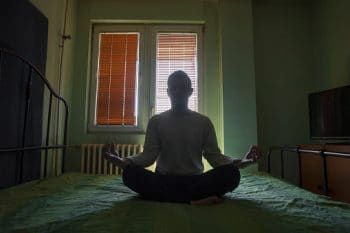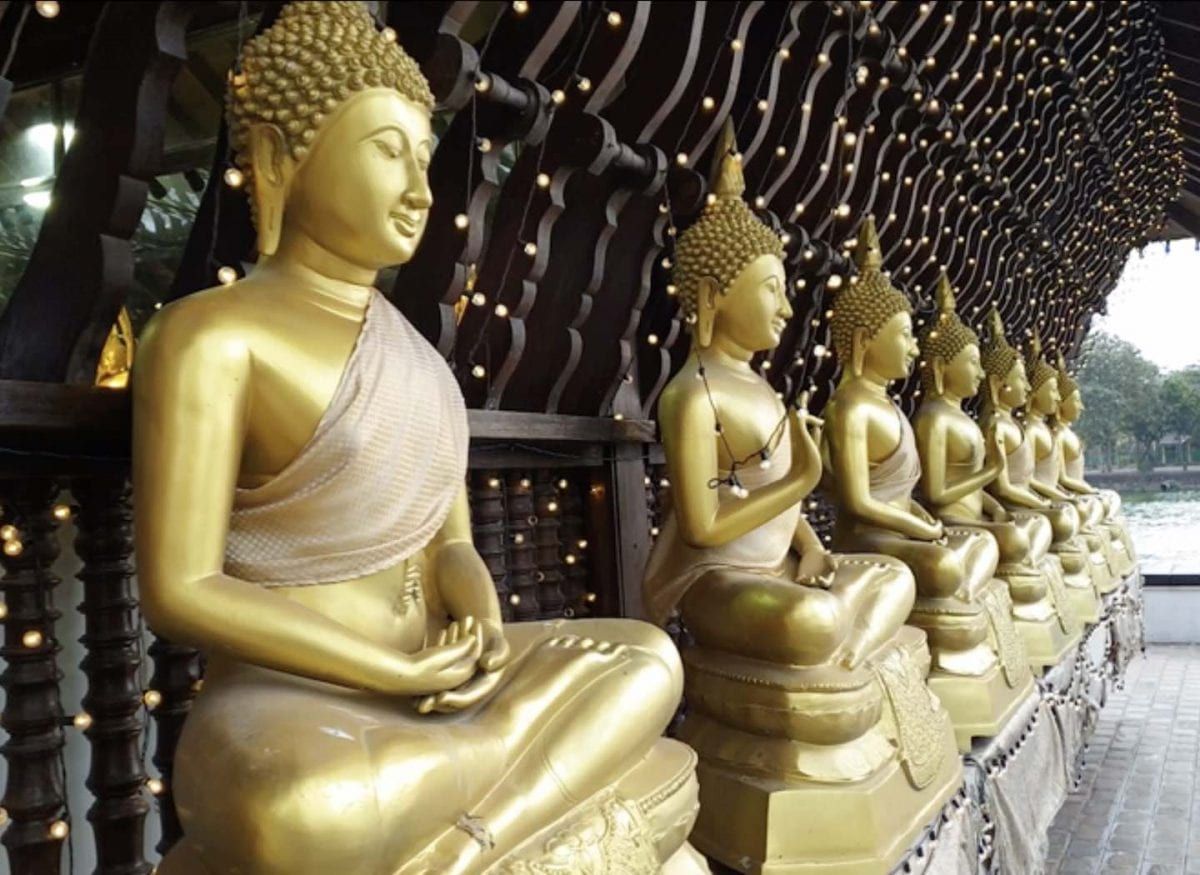Mulla Nasrudin was holding a pair of scissors and diligently working on what seemed like oblong tablets.
“What are you doing?” his friend asked him as he saw that tens of caplets had been snipped from both sides.
“I’ve to take this medication,” Mulla said, “and the doctor warned me that this can cause indigestion, dizziness, fatigue and a whole host of other undesirable problems.”
“So?” The friend looked puzzled.
“Well, it’s no rocket science, my friend,” Mulla said slicing the edge of another tablet. “I’m just getting rid of the side effects.”
While it is no surprise that meditation has been hailed as one of the greatest discoveries in the evolution of human consciousness, like all good things, it comes with certain side effects. Particularly, when it’s done excessively. Call them epiphenomena if you will. As some of you may know, a big part of my spiritual journey involved prolonged periods of intense meditation. Most of what I did was neither sane nor natural. And, I had no idea if it would amount to anything at all.
Having said that, I thought maybe I should share with you some bits of my journey of several thousand hours and the side effects of meditation. I feel it’s important to outline how I clocked those hours because they have a bearing on the results produced by meditation. In this writeup, I’m shedding some light on the intensity of practice. In the next one, I’ll write about the side effects of meditation.
So just to set the record straight, between the ages of 12 and 30, over a period of 18 years, I did roughly 8,000 hours of meditation. That’s 8000 hrs spread over 6570 days. It’s not that I meditated for an hour-plus every day as I did miss my practice on more occasions than I care to count, sometimes out of laziness and other times, busyness. But in these 18 years, I did over 40 different sadhanas, each stint averaging 40 days. During these spells, I meditated an average of 4 hours daily. That makes it 40 stints x 40 days x 4 hrs = 6400 hrs. The remaining 1600 hrs were done over other days. And, I am being conservative with these figures.
From Aug 2010 – Sep 2011, a period of approximately 375 days (as nearly 40 days got wasted in travel and arrangements, etc.), is when I put in the bulk of the effort and logged over 5500+ hours in the wilderness of the Himalayas. On many days, 150 to be precise, I meditated up to 22 hours daily and on the remaining days, it was between 16 and 18 hrs depending on the nature of my sadhana.
Finally, once again, from Jan-Aug 2012, in my beautiful tiny hut in the ashram, I invested another 8 hrs daily in meditation (with about 25 days of break spread across those months). That’s circa 210 days x 8 hrs = 1680 hrs.
That brings the total to 8000 + 5500 + 1680 = 15000+ hrs of meditation. It was important to share this detail with you so we may establish that my practice was divided into four kinds of spells, each one requiring a different level of concentration and stress on the brain. As follows:
Ordinary Meditation
This was when I meditated an average of one hour per session. During most of these sessions, my mind experienced very limited quietude. It would wander off within seconds and I wouldn’t even realize that I had not been meditating but thinking other thoughts. 1600 out of the 15000 hours were logged in this manner. During these sessions, there were no major changes that I noticed in myself in any way. My thoughts, life, philosophy, living, everything had been ordinary. Having said that, my memory did get better with each passing year. I can’t say if it was because of meditation, though it might well have been.
Pro Meditation
This was during the stints when I meditated an average of four hours every day. More than one-third of the 15,000 hours were completed in these sessions. What I discovered was that these sadhanas did lead to greater awareness, heightened sensitivity, and some blissful experiences but nothing to write home about. Truth be told, sometimes I felt relieved that thank God a certain 40-day period was over. Most of these sadhanas I did while I was juggling my work, studies, and spiritual pursuit. I can’t really pinpoint any specific or measurable results other than what I just wrote. In other words, if someone came to me and said, “I’ll meditate for four hours every day for the next forty days or weeks. What can I hope to gain?” My answer would be, “Sorry, but no one can predict that. If you train yourself to intensify your practice, then of course, it’s a different story altogether.”
Intense Meditation
This was during some of my sadhanas where I meditated up to 8 hours every day. Often this would be divided equally into two sessions or sometimes five hours in the morning and three at night. These stints were extremely tiring but I had all kinds of visions, hallucinations, and some remarkable experiences. I often maintained a meticulous log of each day of sadhana. I had always wanted to do the 8 hrs in one go but my body hadn’t yet been trained and I realized that after about 3 hours of continued meditation, there was no concentration or quality. So for the most part, I would stick with two sessions. These sadhanas of intense practice brought to me many transformative moments. My first experience of deep absorption with razor-sharp awareness was during one of these spells.
Peak Meditation
This was the most challenging and most rewarding phase of my spiritual journey some of which I’ve documented in my memoir. The real challenge isn’t the aches and pains your body goes through but maintaining one-pointed concentration for such long spells when you are surviving on one meal a day. Eat more and you feel lethargic and sleepy. Eat less and your body is left with no glucose, energy, or willpower. And yet, a certain desperation to know the truth through meditation and years of experience prior to hitting the peak practice gave me the courage and craziness to persist. Let me tell you, at some level, you have to be insane to sit for ten hours unmoving in meditation, get up to eat your meal, and then sit for another ten hours, sometimes twelve. And then repeat it for 150 days without any break in between.
Patanjali in his yoga sutras states tivra-samveganam-asannah (1.21) and mridu madhya adhimatra tatah api visheshah (1.22). That, intense practice brings rapid results and that the intensity of the practice can be mild, medium, or rigorous. In these two verses, he states that an intense desire to attain mastery over the mind is non-negotiable for a sincere seeker.
It’s not hard to see why Patanjali might have said that. In fact, keeping up the intensity (read duration, discipline, and quality) is just about the only difference between “almost there” and “actually there.”
On my own journey, ordinary and pro practice did little. If there came any good from them, it would be that these spells prepared me for intense and peak practice. Think of light meditation as a small dose, its side effects would also be negligible. The hardened tendencies of the mind, those deposits of conditioning and habits that cloak and stiffen the consciousness cannot be scraped with ordinary practice. For, that’ll be like administering an adult suffering from a severe migraine, a pediatric dose of Tylenol. It may have a pleasant taste but the benefit just about stops there.
When it comes to meditation, good enough is not good enough. It has to be right. And, when it is right, believe me, it’s an attainment like no other. The side effects? Coming up… in the next post.
Peace.
Swami
Editorial Note
You may want to know how to meditate to still the mind. Or you may want to know how to meditate to lead a more peaceful life. Either way, we have you covered!
Course
Art of Meditation
Free yourself from suffering and live life to the fullest. Learn the yogic technique of meditation in 4 days (and master it over a lifetime)
The questions below dive into the practice of meditation, the types of meditation practices, the hurdles in meditation and what the best way to meditate is
What are some of the effects that correct meditation can produce?
Each milestone you pass in meditation takes you to a different level of virtuosity in your consciousness. A mere few hundred hours too can infuse plenty of blissful experiences but a few thousand hours will catapult you to another dimension altogether. If you are wondering how to do meditation and if all the effort is worth it, perhaps this may convince you. Every meditator at all levels experiences some or all these side effects of meditation.
Which is the best way to meditate?
I’ve invested a significant portion of my life in experimenting with various forms and styles of meditation. But meditation isn’t about creating an artificial sensitivity, it is about discovering your most natural state — a state of pristine awareness and clarity.

Hence, the system of meditation I prefer the most is Mahamudra because it emphasizes on removing the mental constructs and seeing your mind as is — still, infinite and eternal. Over the years, I’ve practised Mahamudra in both the tantric and non-tantric ways and have found it truly remarkable. Literally, Mahamudra means the great seal. You may interpret it as the seal of stillness, of peace, of bliss, or simply the seal of emptiness.
If there’s any doubt as to how to do meditation the Mahamudra way, allow me to share with you its six fundamental principles – here.
What is the very first step in learning how to meditate?
A lot of you ask how to meditate when you are a busy householder or have a chock-a-block schedule. Well, a burning desire to experience your true nature and an unwavering commitment to your chosen path are the prerequisites. Commit to the practice of meditating daily, even twice a day if you are on the path of meditation.
It is a question of priority. If you carry out an initially intense effort, the flux of purified energy will automatically bring about the required changes. If you tread the path slowly, steadily, and correctly, the urge to increase the intensity will emerge automatically. So, either way, you can get to the destination.
If you still feel you cannot afford the system of dhyana and the practice of meditation is not for you, there is another way.
When I am learning how to meditate, what is the biggest hurdle to cross?
I am going to share with you the four common defects of meditation. I cannot overstate the importance of understanding the four hurdles and applying the correct methods to overcome them. They are – restlessness in meditation, laziness in meditation, thoughts in meditation and images in meditation. Please take all the time you need to grasp, understand, and absorb them if you really want to learn how to do meditation the right way and become an excellent meditator.
This post elaborates on the first hurdle, restlessness in meditation.
How do you meditate when you are feeling lazy?
There are four common flaws that prevent the meditator from experiencing oneness, that exalted state, the natural state of mind. Let me elaborate on the second most common defect, that is, laziness. Laziness during meditation can take the form of the dullness of the mind or lethargy of the body.
If your mind experiences dullness, a kind of sluggishness, the clarity of the object of meditation, the sensitivity of super consciousness disappears. It is as good as sleeping. Your mindfulness has essentially disappeared. So, what do we do?
How do you meditate when you are constantly bombarded by thoughts?
There are four primary hurdles, the pitfalls one has to constantly watch out for quality meditation and noticeable results. Allow me to shed light on the third hurdle: stray thoughts in meditation. The one who is still learning the art of meditation gets easily overpowered by stray thoughts. Causing ripples in the quiescence of your mind, they act like rocks thrown in still water.

There is no mind without thoughts. Something worth remembering. Thoughts are a product of the conditioned mind. Of all the hurdles in meditation, having thoughts is the most natural one. Since it is the result of millions of years of evolution, it is so ingrained, inbuilt, it is the hardest to overcome. It can be done with the right practice. And I tell you how, here.
How do I maintain mindfulness in meditation when I’m hit by stray images or thoughts?
This is the fourth most common defect in meditation – images. In a way, this is the greatest hurdle. It is innate, the natural fabric of a conditioned mind. It does not leave you even while you are sleeping. It’s what causes you to dream.

As you cross the previous three hurdles and try to meditate, you will experience various mental images flashing in front of you from your past. They may seem unrelated. As you try to focus on your object of meditation, you find yourself battling with the appearance of mental images stored in your memory. They severely impede your ability to meditate correctly.
Of course, there is a remedy.
A GOOD STORY
There were four members in a household. Everybody, Somebody, Anybody and Nobody. A bill was overdue. Everybody thought Somebody would do it. Anybody could have done it but Nobody did it.
Don't leave empty-handed, consider contributing.It's a good thing to do today.





Comments & Discussion
259 COMMENTS
Please login to read members' comments and participate in the discussion.